Porsche pulled out all the stops in pulling off the highly “energetic” world premiere of the Porsche Taycan. The Taycan is Porsche AG’s very first all-electric sports car. The Porsche Taycan first electric sports car world premiere launched on September 4, 2019.
Unprecedented Taycan Premiere on Three Continents
As an all-time first (and probably last), the unprecedented Porsche Taycan first electric sports car world premiere took place on three continents — simultaneously:
- North America
- Europe
- Asia
Why these locations? The reasons are two-fold: (1) The three international venues epitomize the three biggest potential regional markets for the Taycan electric sports car and (2) all three sites are synonymous with the generation of sustainable energy:
- Niagara Falls — on the American and Canadian border, for its awe-inspiring grandeur of hydropower
- Neuhardenberg — in Germany, near Berlin, at a solar farm to exemplify solar power, and
- Pingtan Island — in China, at a wind farm in Fujian Province, to call wind power to mind

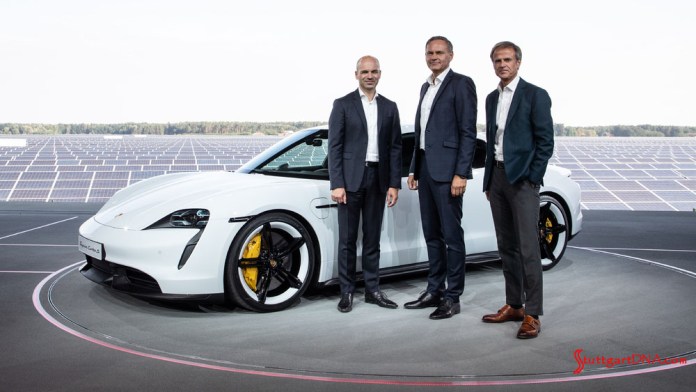
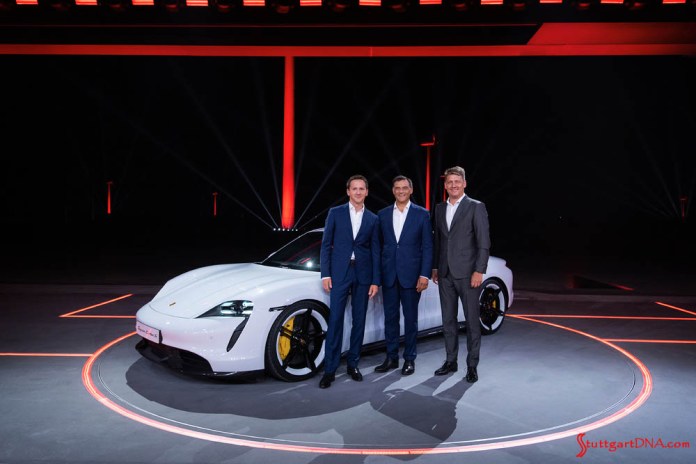
Porsche handpicked these event settings for very good reason: They are ideal backdrops for the introduction of the Stuttgart auto manufacturer’s all-electric-powered four-door sports sedan to the world.
In this way, Porsche touted some of its main objectives for developing and producing the Taycan — sustainability and digitalization. At the time, all three events were livestreamed round the world.
VIEW THE THREE-CONTINENT WORLD PREMIERE BY CLICKING OR TAPPING HERE
So what is to make of these three synchronized international whoop-de-dos? The objective, of course, was to drive home the historic gravity of the moment — that this is Porsche AG’s maiden voyage into 21st century electric automotive mobility. This to all Porschephiles and non-Porschephiles alike is in no small measure a very big deal.
Introducing the world premiere in Berlin, Oliver Blume, Chairman of the Executive Board of Porsche AG, announced, “The Taycan links our heritage to the future. It carries forward the success story of our brand — a brand that has fascinated and thrilled people the world over for more than 70 years.”
Putting an even finer point on it, Mr. Blume pronounced, “This day marks the start of a new era.”
Despite all the global ballyhoo and fanfare, though, two burning questions still linger:
Does the Taycan handle and perform like a real and proper Porsche? Moreover, will über-purist Porschephiles embrace the Taycan as worthy of even giving it the time of day?
Let’s take a quick look-see at Porsche’s recently released revelations, thoughts, specs and features surrounding the Taycan, shall we?
Taycan Overview
The Fundamental Goal
As just alluded to immediately above, Porsche AG’s fundamental goal in developing the new Taycan model line is to bundle the following three aspects seamlessly in the Taycan:
- The performance and driver engagement of Porsche sports cars, past and present
- The daily-driver ease found in Porsche sports cars
- The creation of the first electric Porsche sports car for the future embodying these two foregoing hallmarks that epitomize The Porsche Principle
Reverse Release Strategy
Porsche typically releases each model’s base variant or base trim line, and then builds on that initial release with its increasingly more powerful, more exotic trim lines from there.
For example, Turbo variants are usually the penultimate or ultimate releases. Au contraire, mon frère, this time around.
During this unprecedented tri-continental rollout of its first electric sports car, Porsche AG introduced its top-of-the-food-chain variants of the Taycan — the Taycan Turbo and the most-powerful Taycan Turbo S.
Incidentally, as of this publishing anyway, Porsche AG has not given any explanation as to why it describes these four-door sports sedans — which are devoid of forced-induction internal-combustion engines — as “Turbos.”
Hence, we can only reckon that PAG is attempting to capitalize on the legendary connotations of the word “Turbo,” which is most commonly associated with ruthless Porsche speed and the highest-caliber paragon of The Porsche Mystic.
Perhaps PAG also hopes to connote that the Taycan Turbo and Turbo S are near or at the top of the food chain in terms of Porsche trim lines. Fair enough.

In any case, one of the first tests the Taycan prototype was put through was the setting of the 7:42 record on the Nordschleife.
Porsche E-Performance
Be that as it may, Porsche places these two Turbo and Turbo S variants at the bleeding edge of Porsche E-Performance. This is because both trim lines are among the most powerful production models in Porsche’s product range.
Here are the just-released specs of the Taycan Turbo:
- 670 horsepower (500 kW) potential
- Zero to 60 mph in 3.0 seconds
- Top speed of 161 mph
Taycan Turbo S specs:
- 750 horsepower (560 kW) potential when combined with Launch Control and overboost (which is perhaps the Taycan’s analog to an actual turbo for all Porsche AG’s intents and purposes)
- Zero to 60 mph in 2.6 seconds
- Top speed of 161 mph
As previously mentioned, Porsche AG is reversing its typical graduated distribution strategy. Contrary to traditional release rollouts, PAG plans to release the Taycan S and any other less powerful variants later this year. Porsche will add the Taycan Cross Turismo to the lineup at the end of 2020.
Now a sharper picture of the Stuttgart automobile manufacturer’s earnest commitment to e-mobility is starting to come into focus. Porsche AG announced at the premiere that, by the year 2022, it will have invested more than 6.6 billion bucks in the Taycan and its production. Clearly, PAG is all in on electric mobility.
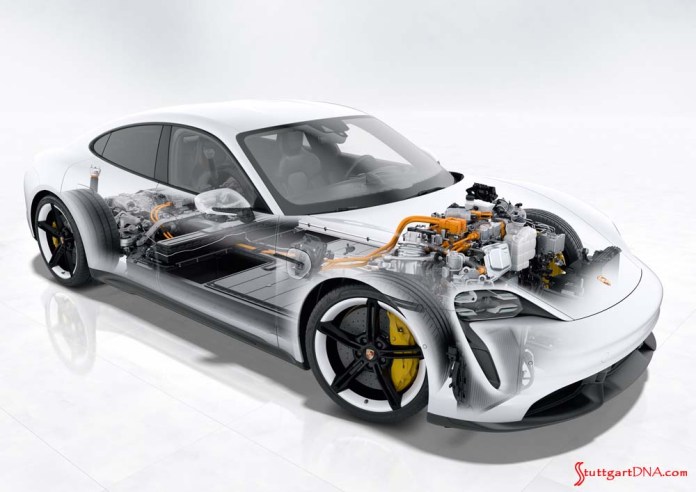
Taycan System Voltage, Electric Powertrain, Transmission, Chassis, Recuperation, Driving Modes and Styling Cues

“Utterly Shocking” System Voltage
All electric vehicles to date run on an aboriginal system voltage of 400 volts. Enter the Taycan, the first production car running on a state-of-the-art 800-volt system.
If you are an “internal-combustionophile” like me, you may be wondering, “So what’s such a big deal about that”?
Well, Porsche schools us on the matter: “Under ideal conditions, the charging time from five to 80 percent State of Charge (SoC) is just 22.5 minutes, with a maximum charging power (peak) of up to 270 kW. The overall capacity of the 800V high voltage battery is 93.4 kWh.
“Taycan drivers can comfortably charge their cars with up to 9.6 kW of alternating current (AC) at home using a standard SAE J1772 connector.”
Zzzzzz . . .
Huh? Oh sorry. Was I snoring that bad?
Anyway, what’s more important is what makes the Taycan run, right? So here goes . . .

Electric Powertrain and Two-Speed Transmission
Porsche has designed what it describes as innovative, exceptionally efficient electric drive motors. One drive motor runs the front axle and the second drive motor spins the rear axle. Hence the Taycan operates as an all-wheel drive automobile.

The Taycan’s transmission, if you can call it that, is a two-speed affair. Another Porsche innovation, the transmission mounts on the rear axle. The transmission’s first gear allows the Taycan to prioritize acceleration from the car’s standing start.
On the other hand, second gear has a very long ratio. Porsche assures us that the design of this long gear ratio ensures optimal efficiency as well as extraordinary power reserves at high cruising speeds.
(Beware! Snorer alert! Insomniacs, rejoice! Here it comes!)

The two drive motors are highly efficient, permanently excited (i.e., possessing a permanent magnet) synchronous mechanisms. The benefits derived from this excited synchronicity amount to extended range and continuous power produced by the electric powertrain.
The electric motor and pulse-controlled inverter (and transmission on the rear axle) unite together in respective compact drive modules on the front and rear axles. These modules boast the highest density (kW per cubic foot of package space) compared to all electric powertrains in the marketplace as of this publishing.
But what would Porsche’s electric motors be without their “hairpin” windings of the stator coils (one asks waggishly)? Apparently, this emerging technology sets the stage for integrating more copper in the stator (whatever that is). This is supposed to increase power output and torque while maintaining the same component volume. (Huh?)
(End, snorer alert.)
Unfortunately, the presumably unprecedented EPA data was not available at the time of this publication.
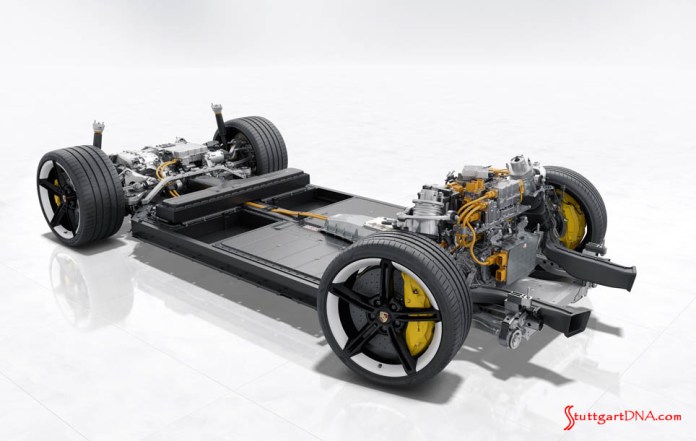
Centrally Networked Chassis Systems
The Taycan’s chassis employs a centrally networked control system. At the heart of this innovative system is Porsche 4D Chassis Control. The system analyzes and synchronizes all aspects of the chassis components in real time.

The major chassis components include, among other mechanisms, the following:
- Adaptive air suspension — incorporates three-chamber technology adapted from the Panamera’s cutting-edge suspension engineering
- Porsche Active Suspension Management (PASM) electronic damper control
- Optional Porsche Dynamic Chassis Control Sport (PDCC Sport) electromechanical roll stabilization system
- Porsche Torque Vectoring Plus (PTV Plus)
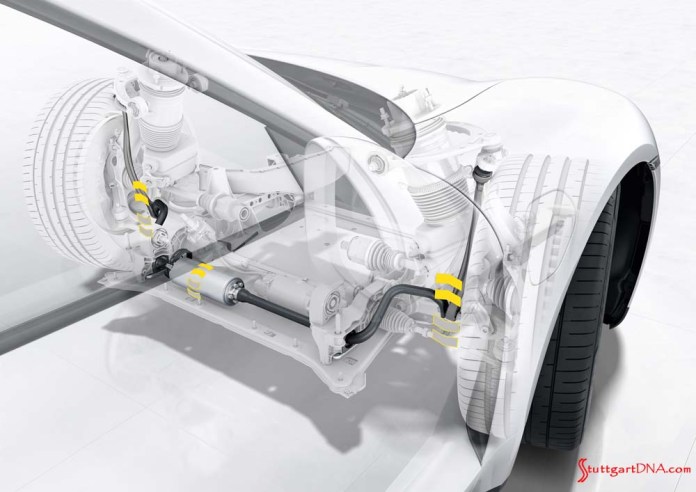
Recuperation System and Braking System

Another important element of the two-motor, all-wheel-drive set-up is its trailblazing recuperation system. The recuperation system’s maximum potential peaks at 265 kW. Porsche declares that this is substantially higher than Taycan marketplace rivals.
Formula 1 fans will recognize that this system is based on the basic principles employed by KERS (Kinetic Energy Recovery System) units found on F1 racecars.

Porsche tested the Taycan recuperation system’s braking. Porsche’s engineers found that the electric motors exclusively execute about 90 percent of day-to-day braking. Conversely, the hydraulic brake system remains blissfully idle during these conventional scenarios.
Multiple Driving Modes
Most if not all late-model Porsche vehicles have a choice of four familiar driving modes. The Taycan boasts them too, in addition to a fifth mode (i.e., the last one listed below):
- Normal
- Sport
- Sport Plus
- Individual — customizable mode
- Range — maximizes operational efficiency
These multiple driving modes enable drivers to tailor their driving experience and pleasure under all road and track conditions. The first-generation Taycan goes one step further with “Range” mode. This new fifth addition allows the driver to maximize vehicle operational efficiency. The goal here, of course, is to extend the Taycan’s traveling range.
External Styling Cues
Porsche points out the following design aspects, asserting they speak volumes about the Taycan’s inherent Porsche DNA:
- Wide and flat look from the front, accentuated by sharply contoured wings inherent in most Porsches
- Highly sculpted side sections
- Sporty roofline that slopes downward into the car’s rear luggage compartment
- Typically Porsche shapely baby-got-back hips, formed by the sleek cabin, tight C-pillar and accentuated rear wings

The Taycan’s rear section also possesses its own distinctive glass-look logo, a feature integrated into the continuous rear light bar. All in all, the overall aerodynamically optimized sleek body shape boasts a drag coefficient as low as 0.22.

A low coefficient is especially all-important for an electric vehicle to enhance and optimize low energy consumption — which lengthens driving range.

Another Taycan benefit is the fact that it has two luggage compartments: 2.8 cubic feet in the front storage area, and 12.9 cubic feet in the rear.
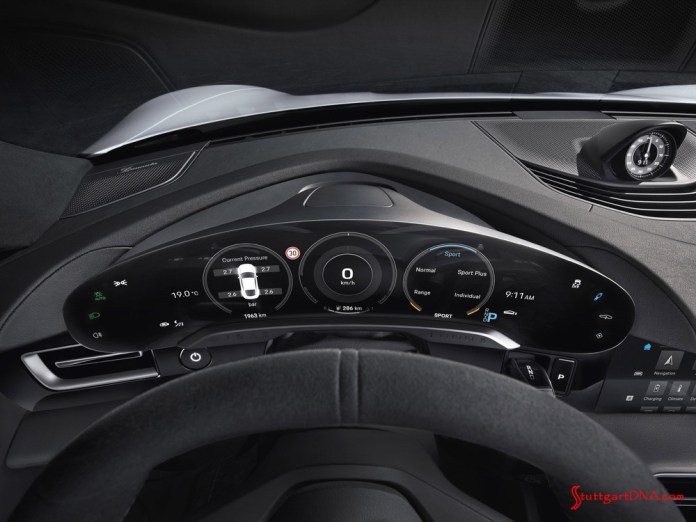
Internal Styling Cues
Not unlike that of the Carrera GT supercar, the Taycan interior serves as the genesis of and template for most if not all future Porsche vehicle interiors in this, the 21st century. The interior marks the beginning of an entirely new Porsche interior architecture:
- Elevated, detached, free-standing, curved instrument cluster, on the highest plane of the dashboard
- Driver-centric cockpit serving as the interior’s focal point
- Centralized 10.9-inch infotainment display screen
- Optional passenger display screen, which combines with the driver display and integrates into a continuous black-paneled glass ribbon spanning the entire dashboard
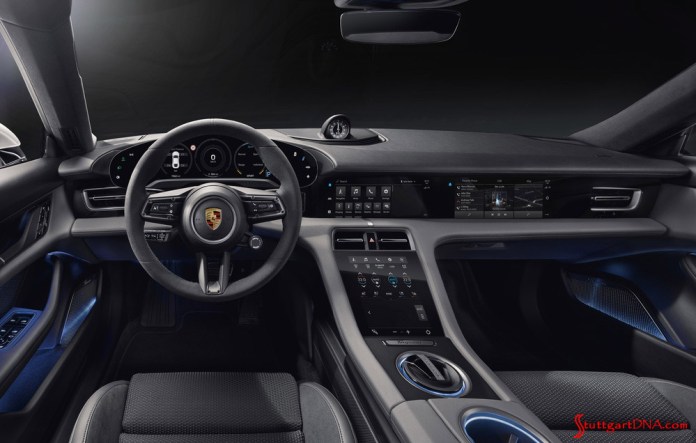
Brand-new to the Taycan interior are intuitive touch operation controls. There is also a vocal-response system. This voice-activation interface can be initially accessed by simply uttering, “Hey, Porsche,” followed by the desired vocal request.
Consequently, the usual suspects of overwhelming three-dimensional buttons, switches and controls chronically denigrated with respect to previous Porsche automobiles survive at a very bare minimum in the Taycan.
Another Porsche first is the option of a completely leather-free interior. Instead, Porsche introduces what it calls “innovative recycled materials” on offer. Along with other elements unique to the Taycan, this is in keeping with the concept of sustainability for Porsche’s first all-electric sports car.

The Taycan has the lowest center of gravity of all Porsches that ever came before it. This is possible only because of the low, low position of the humongous battery. That battery has “foot garages.” These are recesses hollowed out back at the rear foot well for rear-passenger comfort.
This low center of gravity also enables the classically low roofline typical of sports cars in general, and Porsche automobiles in particular.
Performance vs. Sustainability
So did Porsche AG successfully accomplish its objective of blending Porsche performance with sustainability? More specifically, did PAG deftly bundle Porsche driver engagement, Porsche day-to-day driver comfort as well as zero emissions and 21st century sustainability— all seamlessly embodied in the Taycan?
According to Michael Steiner, Member of the Executive Board of Porsche AG – Research and Development, “We promised a true Porsche for the age of electric mobility — a fascinating sports car that not only excites in terms of its technology and driving dynamics, but also sparks a passion in people all over the world, just like its legendary predecessors have done.”
Mr. Steiner puts an even finer point on it, declaring, “Now we are delivering on this promise.”
Well, it seems compelling to me after digesting all of the above — but the jury is still out, actually. The jury is still out because we have to wait and see what happens when multiple analytical test runs and test drives thoroughly put the Taycan through its paces.
Speaking of which, check out these preliminary shakedowns so far:
Feel free to let us know what you think about the Taycan and/or this post by contributing your comments below. We greatly appreciate your input.
Please share your COMMENTS with everyone by scrolling down to the “LEAVE A REPLY” space below at the very bottom of this page. Your input is highly valued by us and much appreciated!








